Noticing that your iPhone screen keeps going black? Or does your iPhone screen randomly black out? Experiencing unexpected restarts, a frozen screen, or your device won’t turn on? If so, you are not alone in experiencing the iPhone black screen bug!
Some users are experiencing problems with black / frozen screens; after upgrading to the latest version of iOS. More specifically, your iPhone ( or iPad) screen may go black when you launch an app.
Users stated that this problem occurs when they launch an app for the first time. Some users also reported that this black screen problem starts happening after making a call with Voice Control. 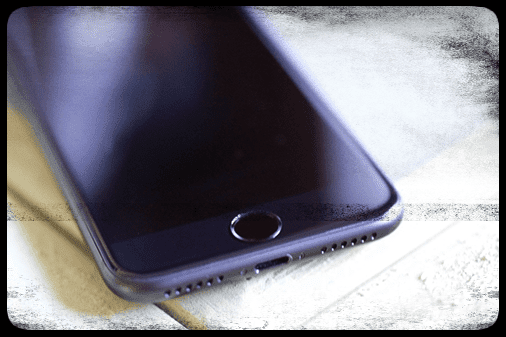
Contents
- 0.1 Related Articles
- 0.2 It seems that this is not a random issue. We were able to replicate this bug by doing this:
- 1 Black or Frozen Screens On iPhone 8?
- 2 Is Landscape Mode Causing Your iPhone Screen To Go Black?
- 3 Force a Restart!
- 4 Connect to iTunes
- 5 iPhone Keeps Resetting/Rebooting Itself After iOS 11.x Update?
- 6 Bad App Behavior?
- 7 If you are experiencing this iPhone black screen bug, troubleshoot with these tips:
- 8 Nothing Helping with iDevice Black Screen?
- 9 NO Time? Check out our Video Tips!
- 10 Battery or Hardware Issue?
- 11 READERS TIPS
Related Articles
- iDevice will not turn on: How to fix a dead device
- iPhone or iPad Keeps Resetting Itself, How To Fix
- iOS: Everything about DFU and Recovery Mode
- iPhone Keeps Resetting/Rebooting Itself After iOS 11.1.2 Update
It seems that this is not a random issue. We were able to replicate this bug by doing this:
- Disable Siri (if it is enabled) by going to Settings > Siri & Search (or just Siri for older iOS)
- Lock your iPhone screen by pressing sleep/wake button
- Activate Voice Control by pressing and holding the Home button or pressing the Side Button for phones and iPads without a Home Button
- Call somebody using Voice Control (you may say ‘call Tom,’ for example)
- Talk then end the call.
- Now you may experience this bug. Just open an app that wasn’t previously opened. Opening any app results in an entirely black screen.
It seems that mostly older models iPhones such as iPhone 7, 6S models, iPhone 6, iPhone 6 Plus, iPhone 5, iPhone 5s and iPhone 5c are affected by this issue.
Black or Frozen Screens On iPhone 8?
Symptoms include unexpected restarts, frozen screens, or the device won’t turn on.
For 3 years from your date of purchase (or first retail sale if you purchased a used device,) Apple will repair eligible iPhone 8s free of charge.
To see if your iPhone 8 qualifies, use Apple’s Serial Number Checker.
Is Landscape Mode Causing Your iPhone Screen To Go Black?
Change Your Screen Orientation
Some readers tell us they fixed this problem by changing their iPhone’s screen orientation–so if you see a black screen in portrait mode, switch to landscape or vice-versa.
Watch How Your Hold Your iPhone
Another potential cause is just how you handle your iPhone. If you are one of those iFolks that like to hold your phone near the top of the screen, this could be why your iPhone goes dark. 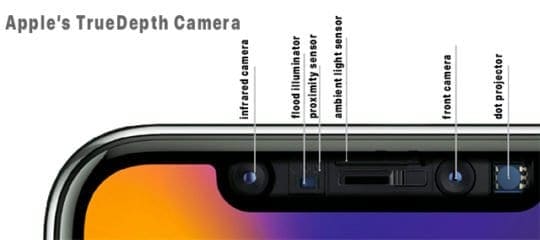
The proximity sensor is located at the top of your iPhone’s screen when holding it in portrait mode–you may block or otherwise obstruct the proximity reader. And hence, cause your iPhone to blacks out because your iPhone thinks you are on a call and placed the phone up to your ear.
Try to keep your hands holding the device by the sides or bottom–avoid the top of the screen and upper edges.
Force a Restart!
Connect your device to the charger and plug directly into a wall outlet (not a USB port on a computer), then force a restart
- On an iPhone X Series, iPad without a Home Button, iPhone 8, or iPhone 8 Plus: Press and quickly release the Volume Up button. Press and immediately release the Volume Down button. Then, press and hold the Side button until the Apple Logo appears
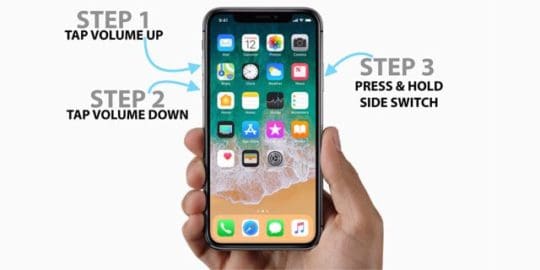
- On an iPhone 7 or iPhone 7 Plus: Press and hold the Side and Volume Down buttons at the same time. Keep holding them until you see the Apple Logo
- On an iPhone 6s and earlier, iPads with a Home Button, or iPod touch: Press and hold both the Home and the Top (or Side) buttons at the same time. Keep holding them until the Apple Logo appears
If Forced Restart Didn’t Help
Connect your device to the charger via a wall outlet (not a computer port) and let it charge for at least one hour. Then try to turn it on again or force restart. 
Connect to iTunes
If charging or forced restarting didn’t fix your black screen or unresponsive issue, let’s connect your device to a computer that has iTunes installed, preferably the latest version.
If you don’t have a computer, ask a friend or family member to use theirs or visit an Apple Store or Apple Reseller and ask them to use one of their in-store Macs.
Using iTunes, follow these steps in strict order
- Open iTunes on the computer
- Connect the cable to the computer and then connect the cable to the device
- Once you connect the device, force a restart on your device
- On an iPhone X Series, iPad with no Home Button, iPhone 8, or iPhone 8 Plus: Press and quickly release the Volume Up button. Press and immediately release the Volume Down button. Then, press and hold the Side button until you see the recovery mode screen
- On an iPhone 7 or iPhone 7 Plus: Press and hold the Side and Volume Down buttons at the same time. Keep holding them until you see the recovery mode screen
- On an iPhone 6s and earlier, iPad with a Home Button, or iPod touch: Press and hold both the Home and the Top (or Side) buttons at the same time. Keep holding them until you see the recovery mode screen
- Make sure you see the recovery mode screen on your device before proceeding (see image below.) If you don’t see this screen, try another force restart
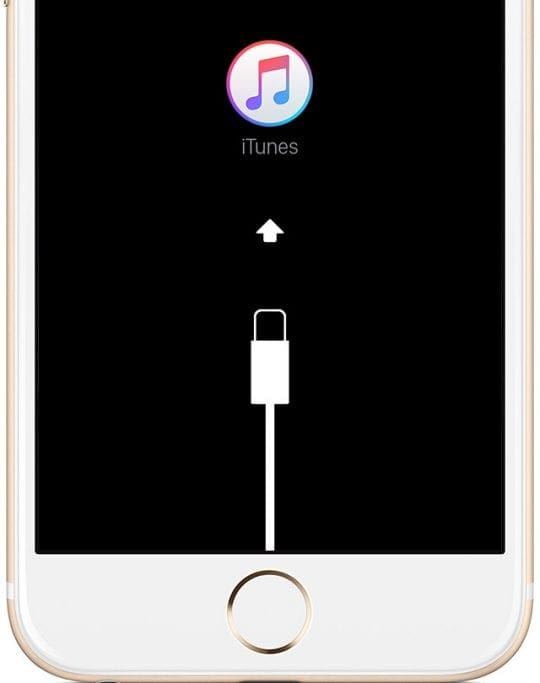
- When iTunes shows the message that there’s a problem with your device that requires a restore or update, choose Update. iTunes tries to reinstall iOS without erasing your data
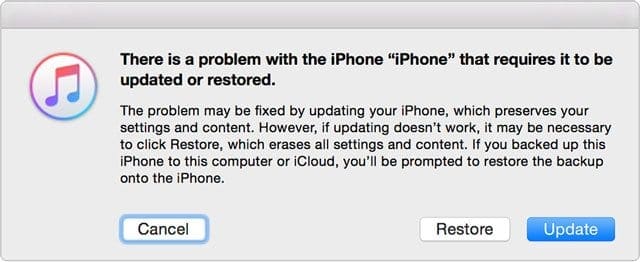
- If more than 15 minutes elapse, your device exits recovery mode automatically. Try to force restart again.
iPhone Keeps Resetting/Rebooting Itself After iOS 11.x Update?
Please check out this article for specific steps for iOS 11 problems.
Bad App Behavior? 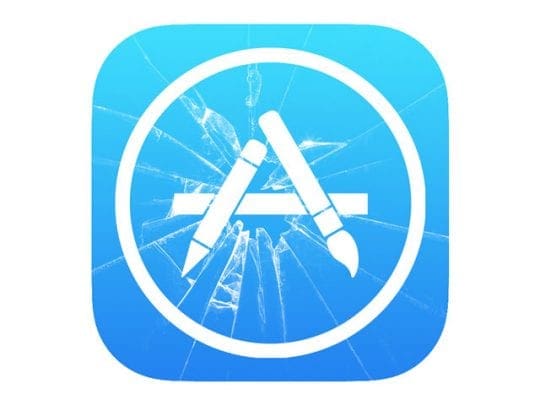
If the black screen is occurring at random times, the problem is likely caused by a badly behaving app–or runaway app.
Try and spot the problematic app!
- Double press your home button or swipe up your home gesture bar and close all open apps by swiping the app preview up and off the top of your screen.
- Once you close all apps, open the apps one by one and check if the problem returns.
- Keep an eye on your battery usage
- If you notice a sudden rapid depletion of your battery, take note of the app you just opened–it might be the problem
- Close that particular app and continue opening other apps one-by-one
- Go through all your apps and see if any apps are causing the problem(s)
Some apps aren’t programmed well and lead to issues with crashing, black screens, and rapid battery depletion.
If you are experiencing this iPhone black screen bug, troubleshoot with these tips:
- We were able to fix this bug by just enabling Siri. If Siri is disabled, go to Settings > Siri and turn Siri on
- Change the Date on your iPhone. Tap on Settings > General > Date & Time. Disable the ‘Set Automatically’ feature and manually set up a time for a date that was in the past. Then, restart your device. Once the reboot issue is resolved, change your date and time settings back to ‘Set Automatically.’
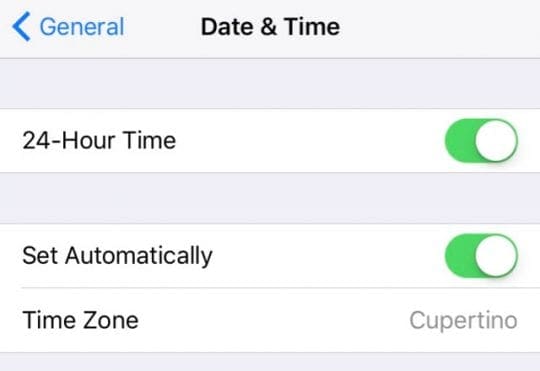
- Change Display Zoom View from “Standard” to “Zoomed” or “Zoomed” to “Standard”; depending on your original setting
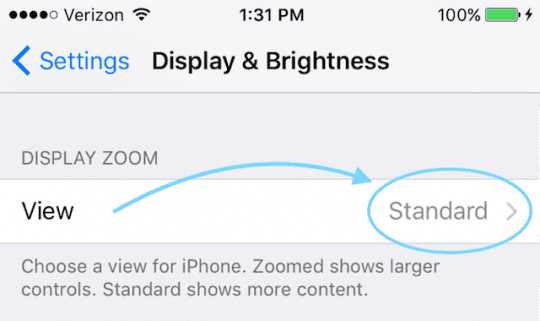
- If the tip above did not solve this problem, try this: Tap Display Zoom View and choose Zoomed and tap “Set.”
- A message will say “Changing Display Doom will restart iPhone” and tap “Use Zoomed.” After your iPhone restarts, now tap Standard > Set and Use Standard.
- Reset your iDevice’s settings. Go to Settings > General > Reset > Reset All Settings.
- This reset does not impact ANY data but does return to defaults things like your accessibility settings, wallpapers, and removes any stored WiFi passwords
- Tap Settings > General > Accessibility > Display Accommodations (or on older iOS, simply Settings >Display & Brightness) then disable “Auto-Brightness“
- Restart your device by pressing and holding the on/off button.
- Remove and reinstall any app(s) that you are having problems with
- Tap and hold the app, then tap the (x) sign when it jiggles. Then go to the App Store and re-download the same app
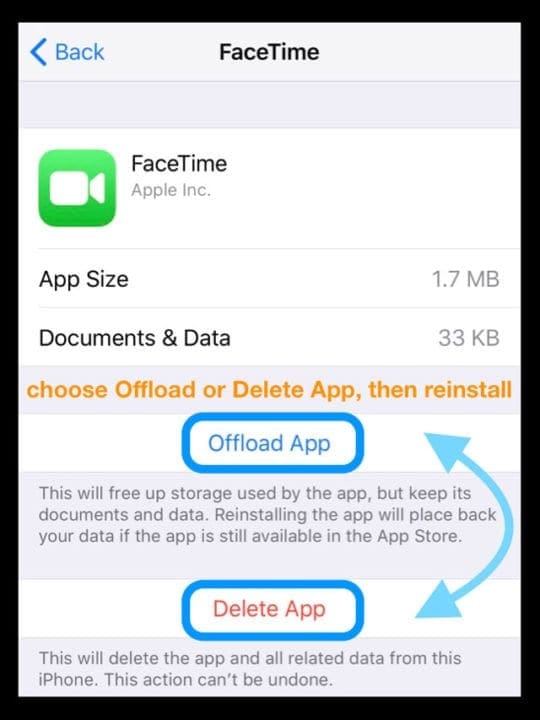
- Or use Settings > General > Storage and delete or offload apps from there
- Tap and hold the app, then tap the (x) sign when it jiggles. Then go to the App Store and re-download the same app
Nothing Helping with iDevice Black Screen?
If none of these tips work on your device, consider using DFU Mode. DFU (Device Firmware Update) allows your iPhone, iPad, or iPod touch to be restored from any state.
NO Time? Check out our Video Tips!
Battery or Hardware Issue?
If it’s a battery problem that’s causing your iPhone to go black, you may need to replace it. Before you go ahead and seek a replacement, check your current battery health (if possible) using iOS 11.3 and above’s Battery Health (beta.) 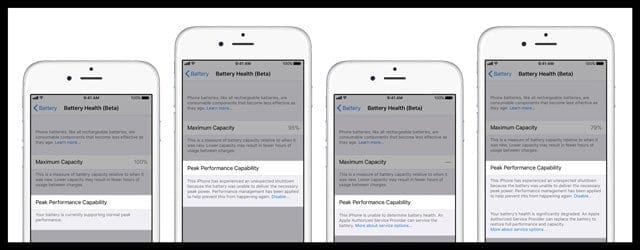
If you are unable to verify your battery health because you cannot get your iPhone to get beyond that black screen, contact Apple Support and ask them to run diagnostics on your iPhone. Let’s find out if it’s likely a battery issue before proceeding.
Sadly, sometimes our problems are symptoms of the iPhone, iPad, or iPod Touch hardware failing. If your battery is draining and your iDevice reverts to a black screen in just a few minutes, it’s likely there’s a problem with the motherboard.
These are expensive repairs, so if your device is not covered by AppleCare+, contact Apple Support and find out your repair or replacement options.
READERS TIPS
- In Settings > General > Reset > Reset All Settings helped out with this issue
- It’s best to contact Apple Support if you have the following problems:
- A black screen after charging but you can hear alerts, sounds, and vibrations
- Your device chirps when you unmute it and connect it to power
- The screen is on, but it doesn’t respond when you tap, slide, or try other gestures
- Your device is stuck on the Apple logo, displays a solid color, or isn’t recognized in iTunes

